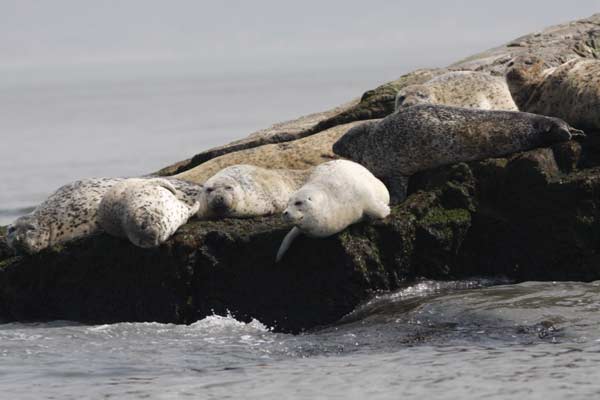Spotted seals get special attention
Updated: 2014-05-02 10:10
By Zhu Chengpei and Zhang Xiaomin (China Daily)
|
|||||||||||
 |
|
Liaodong Bay is one of the southernmost of the eight breeding regions for spotted seals in the northern Pacific Ocean. [Photo by Ma Zhiqiang / for China Daily] |
Every year, the seals swim into the Bohai Sea in November. When the sea is frozen, from December to February, they give birth to babies at the edge of ice floes in Liaodong Bay. They then scatter to different habitats around the Bohai Sea. Pups learn skills, and big ones molt before they swim out to the Pacific Ocean in May.
According to the studies of Ma and his colleagues, spotted seals have another three habitats in the Bohai Sea besides this near Piantuozi - the inlet of the Shuangtaizi River in Panjin of Liaoning province, the Huping Island in Dalian, and the Miaodao Islands of Shandong province.
On March 16, Ma took his colleague Zhang Peijun and PhD candidate Yang Liangliang from Xiamen University to Piantuozi to collect materials for their research on the characteristic calls and utterances of spotted seals.
When the boat pulled into shore, they stepped onto a beach covered with mounds of oyster shells and put their equipment and belongings at a patch of flat land by the foot of a hill.
"I always put up the tent here. Several steps toward the sea and looking left, I can enjoy an unobstructed view of the seals' resting place," Ma says, pointing to the reefs 200 meters away.
Two seals were lying back-to-back on a projecting rock surrounded by water. They looked around like sentinels. Five others were swimming in a row with their heads exposed to the surface.
These lovely creatures are vigilant. If they are resting on the reefs and see a boat passing by, they immediately dive into the water, one by one. But bigger ones, probably old enough to judge a safe distance, are slow to move, just looking up while continuing to rest, Ma says.
Ma recalls that once he saw a dozen seals playing in the water.
"It is not commonly seen. Standing on the top of the hill, I saw two currents going mixed there. The seals were probably enjoying the swift stream and caught fish. They lined up, dived below and rose to the surface alternately - like a water ballet, very interesting," Ma says. Two years later, he is still excited about that scene.
During the daytime, Ma observes the seals without even taking a nap. It helps him learn their timetable and habits.
They start to dive into the water at 8 am and come back to the reefs for the night beginning at 5 pm.
When night falls, Ma walks under the stars. Then he listens to the radio for a while and falls asleep to the sound of the wash of waves.
Not far away, there comes the seals' sound - "Honk, honk, honk "
At daybreak, he opens his eyes and takes photos that focus on the reefs. He can get the total number of the group only at dawn when all of them are resting on the beach.
Related Stories
Festivities sealed with a kiss 2013-12-20 07:39
Presidential seal of approval 2014-01-11 10:53
Get beautiful without harming animals 2014-04-02 08:38
Chinese consume too much food from animals, experts say 2014-02-13 07:09
Cosplay diner attracts China's animation fans 2014-01-14 09:20
Today's Top News
China, Russia to hold joint military exercise
Li's trip to cement China-Africa ties
3 dead, 79 injured in Xinjiang blast
China, Australia discuss MH370
Russia's FM scolds West for imposing sanctions
Obama's trip not to achieve goals
Media mogul interested in Clippers
Director enjoys overseas success
Hot Topics
Lunar probe , China growth forecasts, Emission rules get tougher, China seen through 'colored lens', International board,
Editor's Picks

|

|

|

|

|

|





